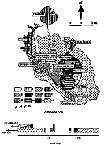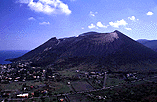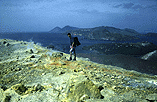| Vulcano
index |
||
| Geological evolution | Eruptive history | 1985-1995 unrest |
| Volcanic hazards | References | Web sites |
| Latest news | ||
Vulcano seen from the Quattrocchi lookout on Lipari in April 1995
Vulcano Volcano, Italy
volcano number: 0101-05= (according to Volcanoes of the World, 1994 edition)
summit elevation: 500 m
location: 38.404°N, 14.962°E
![]()
Introduction
![]()
"A volcanic hazard exists where there
is the potential for loss of life or property as the direct result of
volcanic activity. The major effects of all activity at Fossa are confined
to within 2 km of the vent. The village of Porto with a population of
about 250 inhabitants lies within this zone to the north of the main cone.
During the summer the population of this town swells to more than 10,000.
It is quite dangerous for a village to be located
so close to an active volcano."
Quoted from Frazzetta
et al. (1984). Emphasis (in green color) set by Boris Behncke.
Vulcano has three population centers, the smallest of which is Gelso on the S tip of the island. The village of Piano lies on the marvellous plateau of the same name that constitutes the south-central portion of the island. A complex settlement named Vulcano Porto extends from the immediate N base of the Fossa cone to the isthmus connecting Vulcano with Vulcanello and covers large parts of the Vulcanello peninsula.
During the historical period, the Fossa cone and Vulcanello have been the site of frequent and vigorous eruptions, the most recent of which occurred in 1888-1890 at the Fossa. More recently, crater of the Fossa, known as the Gran Cratere, has been the site of volcanic unrest (most notably, an increase of the fumarolic activity) which began around 1985 and ended in 1995 without culminating in an eruption. This episode of unrest has triggered increased public awareness about the volcanic risk at Vulcano, and intense studies of the volcano and its behavior of which the references cited below are only a small fraction. It is the aim of these pages to present a comprehensive image of the volcano, its behavior, and hazards.
|
Vulcano
at a glance
|
||
|
Area:
21.2 km2
|
Notable morphologic
features: Residents: about 500 (permanent, but during the summer season up to 10,000 people stay on Vulcano each day) |
|
 Geological sketch map of the island of Vulcano, showing eruptive centers and stratigraphic units. |
|
|
From Ventura (1994)
|
References
De Astis G, Dellino P, De Rosa R and La Volpe L (1997) Eruptive and emplacement mechanisms of widespread fine-grained pyroclastic deposits on Vulcano Island (Italy). Bulletin of Volcanology 59: 87-102.
De Astis G, La Volpe L, Peccerillo A and Civetta L (1997) Volcanological and petrological evolution of Vulcano island (Aeolian Arc, southern Tyrrhenian Sea). Journal of Geophysical Research 102: 8021-8050.
Barberi F., Bertagnini A and Landi P (1994) Italian volcanic activity during 1991-1994. Bollettino di Geofisica Teorica ed Applicata 36: 639-736 (Vulcano: pp 658-678).
Dellino P, Frazzetta G & La Volpe L (1990) Wet surge deposits at La Fossa di Vulcano: depositional and eruptive mechanisms. Journal of Volcanology and Geothermal Research 43: 215-233.
Frazzetta G, Gillot PY, La Volpe L & Sheridan MF (1984) Volcanic hazards at Fossa of Vulcano: data from the last 6000 years. Bulletin of Volcanology 47: 105-124.
Frazzetta G & La Volpe L (1991) Volcanic history and maximum expected eruption at "La Fossa di Vulcano" (Aeolian Islands, Italy). Acta Vulcanologicy 1: 107-113.
Frazzetta G, La Volpe L & Sheridan MF (1983) Evolution of the Fossa cone, Vulcano. Journal of Volcanology and Geothermal Research 17: 329-360.
Keller J (1980) The island of Vulcano. Rendiconti della Società Italiana di Mineralogia e Petrologia 36: 369-414.
Mercalli G & Silvestri O (1891) Le eruzioni dell'isola di Vulcano, incominciate il 3 Agosto 1888 e terminate il 22 Marzo 1890. Relazione Scientifica. Annali dell'Ufficio Centrale di Meteorologia e Geodinamica 10 (4): 1-213.
Montalto A (1996) Signs of potential renewal of eruptive at La Fossa (Vulcano, Aeolian Islands). Bulletin of Volcanology 57: 483-492.
Sheridan MF, Frazzeta G & La Volpe L (1987) Eruptive histories of Lipari and Vulcano, Italy, during the past 22,000 years. In: Fink JH (ed) The emplacement of silicic domes and lava flows. Geological Society of America Special Paper 272: 29-33.
Valentine GA, Palladino DM, Agosta E, Taddeuci J, Trigila R (1998) Volcaniclastic aggradation in a semiarid environment, northwestern Vulcano Island, Italy. Bulletin of the Geological Society of America 110: 630-643.
Ventura G (1994) Tectonics, structural evolution and caldera formation on Vulcano Island (Aeolian Archipelago, southern Tyrrhenian Sea). Journal of Volcanology and Geothermal Research 60: 207-224.
Copyright © Boris Behncke, "Italy's Volcanoes: The Cradle of Volcanology"
Yes, there's an ad on this page. This is related to a counter system I use to obtain web statistics and furthermore it's there to let me receive a minor economic input for this site which has become more and more extensive, and still work on this site is being done by myself exclusively (except taking some of the photos). I hope no one is offended by this commercial bit, but rather click on the banner to help me keep the site alive.


